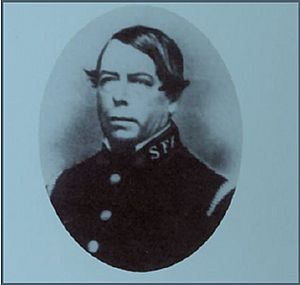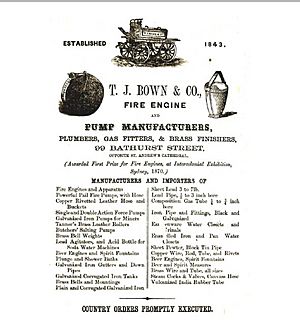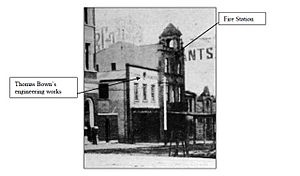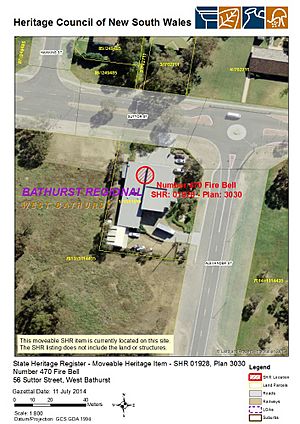Number 470 Fire Bell facts for kids
Quick facts for kids Number 470 Fire Bell |
|
|---|---|
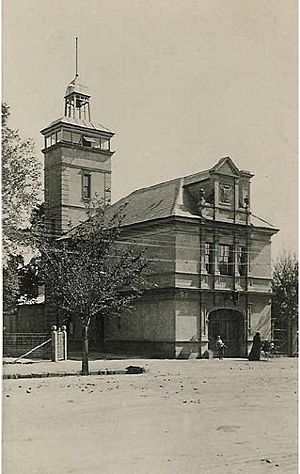
Original 1887 Bathurst Fire Station, observation tower and bell. Circa 1891
|
|
| Location | 56 Suttor Street, West Bathurst, Bathurst Region, New South Wales, Australia |
| Built | 1855–1855 |
| Architect | John C. Wilson |
| Official name: Number 470 Fire Bell; Sydney Insurance Companies Fire Bell; Bathurst Fire Bell | |
| Type | state heritage (movable / collection) |
| Designated | 11 July 2014 |
| Reference no. | 1928 |
| Type | Fire Control Objects (movable) |
| Category | Utilities - Fire Control |
| Builders | Gorbals Brass and Bell Foundary, Glasgow |
| Lua error in Module:Location_map at line 420: attempt to index field 'wikibase' (a nil value). | |
The Number 470 Fire Bell is a special old fire bell located at 56 Suttor Street in West Bathurst, Australia. It's considered a heritage item, meaning it's an important part of history. This bell was designed by John C. Wilson and made in 1855 by the Gorbals Brass and Bell Foundry in Glasgow, Scotland. It's also known as the Sydney Insurance Companies Fire Bell or the Bathurst Fire Bell. It was added to the New South Wales State Heritage Register on 11 July 2014 because of its historical importance.
Contents
A Look Back: Early Bathurst
First People and European Arrival
Long before Europeans arrived, the Blue Mountains area was home to Aboriginal people for at least 12,000 years. The land around what is now Bathurst was lived on by the Wiradjuri people. They moved around in small groups, following the seasons and using the Macquarie River for food.
After the first European explorers crossed the Blue Mountains in 1813, settlement began. Lachlan Macquarie, who was the Governor, officially named Bathurst a town on 7 May 1815. He named it after Lord Bathurst. Bathurst is known as Australia's oldest inland town.
Building the Town of Bathurst
Governor Macquarie chose the spot for Bathurst in 1815. He set aside land for government buildings. At first, he didn't want too many people settling in the rich Bathurst Plains. One of the first land grants went to William Lawson, who was one of the first Europeans to cross the mountains.
The town grew slowly. By 1819, Bathurst had only about 120 people. Most of them lived in a small settlement called Kelso, across the river. The government farm there wasn't very successful and closed in 1828.
The town of Bathurst was properly planned out in 1830 by Thomas Mitchell. The first land sales happened in 1831. In 1832, the new Governor, Sir Richard Bourke, visited Bathurst. He asked for the town to be opened quickly. It's believed that Major Mitchell named the streets, with George Street named after King George III.
Firefighting in Old Sydney
The Bown Family and Fire Brigades
The Bown family played a big part in the history of firefighting in New South Wales. Thomas Bown came to Sydney in 1842. He was an experienced firefighter. He was hired by an insurance company to start a fire brigade. This first brigade didn't last long, but Thomas Bown later started his own business.
By 1851, several insurance companies decided to create their own fire brigade called the "Insurance Companies Fire Brigade." Thomas Bown became its leader. This brigade had twelve volunteers and practiced regularly. Their fire engine was kept at Bown's business in George Street.
In 1864, the Insurance Companies Fire Brigade moved into a new, three-storey fire station on Bathurst Street. Thomas Bown paid for this building himself. He retired in 1867.
Thomas Bown's nephew, Charles Bown, continued the family's firefighting legacy. Charles joined the brigade in 1857 and took over as Superintendent in 1868. He held this position until the Fire Brigades Act was passed in 1884. This Act created the Metropolitan Fire Brigade (MFB). Many of the old firemen joined the new MFB. Charles Bown became the first Chairman of the Fire Brigades Board.
The Story of the Number 470 Bell
Fire bells were very important in the 1800s. They not only called firefighters to action but also helped direct other brigades to the fire. In 1857, Sydney had the Insurance Companies Fire Brigade and two volunteer fire companies.
People realized that the existing fire alarm system wasn't good enough. The bells couldn't be heard across the whole city. A newspaper article from June 1857 mentioned that Thomas Bown had "the largest bell in Sydney." This is the first time we hear about the Number 470 Bell.
The Number 470 Bell was made by John C. Wilson in Glasgow, Scotland, on 20 January 1855. His company, "Gorbals Brass and Bell Foundry," sold many bells to places like Sydney and Melbourne. Their records show that bell number 470 was a large, unpolished "Turret Bell" weighing about 159 kg (350 lbs). It was sold to Thomas Bown through an agent.
People suggested ideas for a better alarm system, often looking at how San Francisco did it. They wanted a loud bell in a central spot that could tell firefighters which part of the city a fire was in.
In June 1860, the Insurance Companies Fire Brigade finally got their "new fire bell." The insurance companies paid for it. Thomas Bown decided where it would be placed. He built a wooden tower behind his engine house in George Street and hung the bell there, 33 feet (about 10 meters) above the ground.
This new bell was meant to be a signal for all three fire brigades in Sydney. It could be rung in different ways to show where a fire was. A red light would also be shown from the tower.
Sometimes, there was competition between the brigades. In 1861, someone complained that the Insurance Company's engine would leave for a fire before the bell was even rung for the volunteer companies.
By 1864, the bell was moved to the new fire station on Bathurst Street. This station had a tall bell tower. However, new technology soon changed things. In 1881, Sydney got its first telephone exchange. The fire brigade quickly started using telephones to report fires. This meant that the big fire bell was no longer needed to call firefighters or signal fire locations.
By 1887, the Number 470 Bell was no longer useful in Sydney. So, Charles Bown, who was now in charge of the Fire Brigades Board, sold the bell to the Bathurst Fire Brigade Board. This was just in time for the opening of their new fire station in Bathurst.
The Bell's Journey to Bathurst
A New Home in Bathurst
After several tries, a fire brigade was finally formed in Bathurst in January 1886. They ordered a fire engine from England and planned a new fire station. The two-storey fire station on Williams Street was finished in early 1887. It officially opened on 25 June 1887.
The original plans for the station didn't include a bell tower. But later, a tower was added. The Number 470 Bell was bought from Charles Bown and placed in this new tower. It had already served in Sydney for many years.
The bell rang for the first time in Bathurst on 17 August 1887, for a fire at the Peers' Newmarket Hotel. However, people soon complained that the bell couldn't be heard very far. The "belfry" (the part of the tower where the bell hung) was too low.
To fix this, the Bathurst Board decided to make the tower about 12 meters (40 feet) taller. This work was finished by March 1891. After the tower was raised, the bell's sound improved greatly. People could hear the alarm even in the farthest parts of the city.
Challenges and Changes
Over the years, the bell faced more challenges. In 1916, it was criticized again. It was too heavy to ring easily because of the long ropes. So, it was lowered from the tower and placed on supports a few feet from the ground in the station yard.
Unfortunately, this made the bell's sound worse again. The officer in charge complained that it couldn't be heard. There was even a suggestion to melt down the old bell and replace it! However, an inspector found that nearby trees were blocking the sound. Once some branches were cut, the bell sounded better.
The Board decided to keep the bell, knowing it was the same one used by the famous Insurance Companies Fire Brigade in Sydney. By October 1917, the bell was hanging in the "hose tower" (which was also used for drying hoses) and was working well. Photos from 1963 show the bell being removed from its original position above the observation tower before the Williams Street station was torn down.
Bringing the Bell Back to Life
Recovery and Restoration
In 1962, as plans for a new fire station in Bathurst were made, the Bathurst Shire Council asked if they could have the old fire bell for their historical exhibition. The Board of Fire Commissioners agreed to lend the bell permanently to the council.
In June 1963, the Number 470 Bell was removed from the bell tower before the old Williams Street fire station was demolished. The bell was then given to the Bathurst District Historical Society. A local resident remembered seeing and ringing the bell in the backyard of the Society's premises at 1 George Street. It was later displayed in the grounds of the Old Government Cottage from 1965.
The bell has now been moved back to the current Bathurst Fire Station. It has been re-hung in the restored upper part of the observation/bell tower, which was part of the original 1887 Williams Street fire station. This tower had been used as an orchid "hot-house" for many years.
On 5 November 2010, the bell and tower were officially reopened. Fire Commissioner Greg Mullins praised the restoration project. Bathurst firefighters, the Bathurst Regional Council, and local community members worked together for three years to restore the tower. Local TAFE students spent about 2000 hours on the project, and local businesses donated materials.
Now, the Number 470 Bell is back where it belongs, reminding everyone of the long and proud history of firefighting in New South Wales. Its connection to the firefighting community, which started with Thomas Bown in Sydney in 1857, has been re-established.
What the Bell Looks Like
The Number 470 Fire Bell is an unpolished "Turret Bell" that is 66 cm (26 inches) tall and weighs about 159 kg (350 lbs). It has the words "John C. Wilson, Glasgow; 1855" carved into it.
The bell is now placed in the remaining part of the original Bathurst fire bell tower. When it was restored between 2007 and 2010, the bell was painted black, and its inscription was painted white. Since it was made by the Gorbals Brass and Bell Foundry, it's probably made of brass. To be sure, the paint would need to be removed. The bell is in excellent condition.
Why the Bell is Important
The Number 470 Fire Bell is very important to the history of New South Wales. It was the first large bell used to create a central fire alarm system in Sydney. It was made in 1855 in Scotland.
This bell is one of the few fire alarm bells left from the time before official fire services were set up in NSW. Its story helps us understand how fires were reported before modern communication systems like telephones.
The bell is also important because of its connection to Thomas Bown. He was a key figure in starting fire services in NSW. The bell was used by the Insurance Companies Fire Brigades and then by the NSW Fire Service for a very long time.
It's also quite rare. It's likely the largest and oldest bell made in the UK that is still part of the Fire and Rescue NSW collection. It's also rare because of how long it was used at the Bathurst Fire Station.
The Number 470 Fire Bell was added to the New South Wales State Heritage Register on 11 July 2014 because it meets several important criteria:
- It shows how history unfolded in New South Wales.
The bell's journey from being Sydney's first large fire alarm to its use by different fire brigades shows how firefighting technology developed in NSW. It represents a key moment in the history of fire services in the state.
- It has a strong connection to important people or groups in NSW history.
The bell is linked to Thomas Bown, who was one of the first professional firefighters in NSW. He bought and sold the bell and led the Insurance Companies Fire Brigade. It also represents the history of fire brigades before official state control and its long connection with the NSW Fire Service.
- It is a rare or unique part of NSW history.
The Number 470 Fire Bell is probably the only large, UK-made bell of its kind left in the Fire and Rescue NSW collection. Other fire stations might have bells, but they are usually smaller, more common, and made in Australia later on. Its long working life in Bathurst also makes it special.


